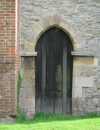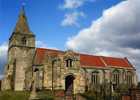For this church:    |
|
 The
north wall The
north wall |
 Door
in the north wall Door
in the north wall |
 Frieze
of shields Frieze
of shieldsover south door |
The chancel and chancel chapel (Lady Chapel) of St Giles’ are of Barton’s time, as is the south aisle. The two-storey south porch with its frieze of shields was added around 1550 by the next generation of Bartons. The only remaining parts of the earlier church are the steeple and low broach-spire (13th and 14th century) and the north wall (probably 13th century) with its 13th century doorway.
Records from 1536, recording the Yorkshire rising, known as the Pilgrimage of Grace, show that there were fords across the Trent at Holme. In November, the Duke of Suffolk who was in Newark, received a report from a John Travers that he had viewed the ford of Holme on the morning of the 17th, saying: “The landing is 680 yards long, and there are two fords in it, each 80 yards broad, enough for 80 horses abreast.” The concern was that the rebels would be able to cross the river in search of food, and so continue their southward journey. However, this may have been an exaggeration because in 1586 a contemporary report said of the fords “40 horses at one and 25 at the other may cross abreast”.
Thoroton (writing in 1677) tells us that:
Holme was formerly a hamlet to North Muskham, but since the river Trent changed its course and separated these two places about the year 1600, it is become a parish of itself. The chapel, however is considered as an appendage in the North Muskham Vicarage.
The change in the river’s course may have been a little before Thoroton thought. Saxton’s map of Lincolnshire and Nottinghamshire, dated 1576, shows Holme on the eastern bank and in 1575 Stephen Surflett of Holme left land to be rented to create income to pay for the upkeep of the flood bank that still exists on the eastern side of the river. The movement of the river was critical to Holme church as the vicar of North Muskham had been used to walking just a short distance and serving the congregation at Holme.
Near the crossroads beyond the church there is the stump of a wayside cross and a similar shaft can be found across the river at North Muskham. A number of historical sources suggest that these two crosses marked the place of the medieval ferry crossing points, which would suggest either a loose interpretation of ‘medieval’ or a much earlier change of the river’s course. Other sources suggest they commemorate floods.
In the mid-17th century everyone in the realm was required to sign an act of allegiance to the King and the established church. The protestation returns of 1641 show that no one in Holme refused to sign. Thomas Simble is listed as vicar and John Mussone as church warden. John Winter was overseer (for the poor of the parish). There were 54 males over the age of 18 who signed the return.
In 1676 an assessment of the villages of Holme, North Muskham and Bathley reported a total of 230 inhabitants with “no popish recusants but 17 other dissenters”.
In 1851, The Religious Census, which existed not only to assess the Church of England attendance but also to see how the non-conformists were growing and by how much, reported that Holme Parish covered an area of 1330 acres with a population of 78 males and 66 females; a total of 144. The church was described as having 130 free spaces and 50 other. On the day of the census there was an afternoon service which was attended by 35 parishioners. By comparison the North Muskham Wesleyan Methodist chapel recorded attendances of 40 in the morning, 22 in the afternoon and 73 in the evening.
During the days of barge traffic there was a ‘spinning post’ fixed in the middle of the river at Holme. A rope was looped over the post and the current was allowed to spin the barge round in preparation for docking at Collingham Wharf on the return journey downstream and back to the Humber.
In 1854 the church’s link with North Muskham was ended when Holme was united with Langford.
By 1900 the population of the village had fallen to 100 and the church had fallen into a much dilapidated state throughout the 18th and 19th centuries. The Rev J C Cox reported that there was slight restoration in 1883 but that on his last visit in July 1911 “the church was in a piteous plight of dirt and decay”.
In the early years of the 20th century, clergy and local historians began to lobby for repair and restoration and in 1912, Ernest Wooley, a member of the Thoroton Society produced a photographic guide to the church and sent a copy to the Rev Mr Aitchison asking for financial support to save the church from decay and destruction. There is no evidence that this request was successful and presumably the advent of the First World War halted any initiatives.
In the same year as Ernest Wooley’s initiative, Bishop Hoskyns, Bishop of Southwell, visited the church. The net value of the benefice was £176. The population was 253 with accommodation in Holme church for 140. In the church day school there were 14 children on the roll. Bishop Hoskyns commented upon the fact that most of the inhabitants in the villages were engaged in agriculture and were very poor.
The whole church was restored in 1932 by Nevil Truman and his architect R Harley Smith.
In 1972 Holme with Langford was amalgamated with Winthorpe.
Between 1983 (when the population had further reduced to 66) and 2002, a series of appeals were launched for repair and restoration.
2003 saw the establishment of the United Benefice of Coddington and Winthorpe with Langford and Holme. From January 2010 the church became part of the group of 11 churches along the East Trent; The United Benefice of North Collingham, South Collingham, South Scarle, Besthorpe, Girton, Winthorpe, Holme, Langford, Clifton, Harby and Thorney.






